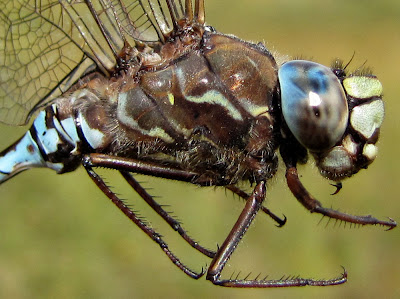Inspired by Brandon Holden's account of the darners he encountered late last month at Netitishi Point on the James Bay coast, I headed out to a favourite peatland along the Trans-Canada, about a half hour NW of Marathon. The weather wasn't ideal - increasingly overcast with temperatures in the high teens.
The peatland is small, only about a square kilometer, and the treed area, about 2/3 of the total, was logged about five years ago. The most low-lying portion is open, treeless fen and this was my destination today. As I bush whacked through the slash piles and dense thickets of black spruce and cedar, I was not encouraged by the scarcity of insects on the wing. I flushed a few Black Meadowhawks (Sympetrum danae) and a lone Lake Darner (Aeshna eremita). The only damselfly I saw all day was a single Spotted Spreadwing (Lestes congener). By the time I reached the open fen, the sun had disappeared behind a huge bank of clouds.
I sat down atop a mossy hummock and took note of the interesting flora. While chewing on my sandwich I was cheered by the reappearance of the sun. A blue-ish darner flew low past me before hovering over a small shallow pool among the sedges. The fly-by impression was that of a smallish mosaic darner with a bright, almost luminescent, blue abdomen contrasting with a black thorax.
I netted it and was delighted, but not surprised, to be holding my first Zigzag Darner (Aeshna sitchensis). Over the next hour, I caught and released several more (all males) and observed perhaps a dozen individuals exhibiting the characteristic low, undulating flight over and between pools …puddles really. Several perched on the shrubs and grasses - none on the ground, a habit often reported in the literature.
[click on images to enlarge]
In the hand I noted some of the Zigzag Darner's distinctive features - the thin squiggly stripes on the sides of the thorax, the unmarked dorsal surface of the thorax, the dark clypeal suture and the concave base of the dark "T" on the top of the head. [The base of the "T" forms a straight line on the closely related Azure Darner (A. septentrionalis) of the northern boreal forest.]
It was also interesting to note that the more abundant mosaic darners - Canada (A. canadensis), Lake (A. eremita) and Interrupted (A. lineata) - were inactive on this relatively cool afternoon.
Ontario is home to about 170 species of damselfly and dragonfly and fewer than half of these have been documented from the Thunder Bay District. Many of those I have yet to see are, like the Zigzag Darner, uncommon denizens of bogs and fens. Who knows what the next trip will turn up?
Canadian odonata enthusiasts will welcome the recent publication of Dragonflies and Damselflies in the hand: An identification guide to boreal forest odonates in Saskatchewan and adjacent regions. This slim, attractive volume is available from Saskatchewan Nature.
Hutchings, G. and D. Halstead.2011. Dragonflies and Damselflies in the hand: An identification guide to boreal forest odonates in Saskatchewan and adjacent Regions. Special Publication #29. Nature Saskatchewan, Regina.







Nice find....someday I'll venture north.
ReplyDelete